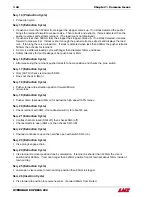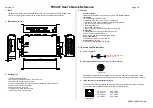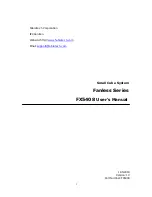
Chapter 2: Common Issues
HYDROBAR EXPRESS 220
2-5
Vibration Issues
The term “vibration” is being used regarding the Hydrobar Express 220, to indicate that the RPM performance of the lathe is physically
deteriorated, to the point of creating an unbalanced rotational oscillation of the bar stock that is detrimental to the machining process.
Various items can cause the bar stock to vibrate, requiring the reduction of the spindle rpm to bring the anomaly back to a normal
controlled rotation. These items can be related (but not limited to) the material, the lathe, the spindle reduction tubes, or the bar feed.
Material
The material must be reasonably straight. LNS has a specification of .5mm / meter (non-accumulative).
If the material is a hot roll type it will not meet our specifications.
If the material has been “cropped” to length the last 6”-12” of the end of the bar may be unusable due to being bent severely in the
process.
Note:
Also, there is a possibility to have a severe angle on the end of the bar, which has been cropped. This might
cause the mis-loading of a new bar into the collet of the bar feed.
When running profiled material (hex, square, etc.), vibration is more likely to occur due to the physical properties of the material,
especially with extremely odd shaped material, in which case a lower rpm is recommended.
The composition of the material also has an effect on the guiding of bar stock. Steel and aluminum bars are relatively easy to guide,
but because of the flexibility and specific weight of brass it is generally going to be more difficult to guide at high speeds.
Lathe
The lathe should be level and on a solid foundation. LNS recommends that the lathe be bolted to the floor.
Spindle Reduction Tube
Ensure that the properly sized spindle liner has been installed (matches guiding channel size).
Ensure that the spindle liner is straight (check total run out).
Ensure that the liner is securely fastened.
Bar Feed
The bar feed must be within proper alignment to the spindle of the lathe.
The proper guiding elements should be used to provide minimal gap between the I.D. of the elements and the O.D. of the bar stock
diameter. Should not exceed 10mm overall gap (5mm per side). Refer to
pg. 6-4 Guiding Channel Reference chart
for the
recommended guiding elements and ordering numbers.
LNS recommends running ISO 100 hydraulic oil in the bar feed. In certain cases, a thicker oil (ISO 150) may produce better results
when guiding profiled material.
Summary of Contents for Hydrobar Express 220
Page 61: ......
Page 143: ......
Page 147: ......
Page 156: ...Chapter 6 Spare Parts 6 9 HYDROBAR EXPRESS 220 Servo Motor Assembly ...
Page 161: ...6 14 Chapter 6 Spare Parts HYDROBAR EXPRESS 220 Hydraulic Pump Assembly ...
Page 163: ...6 16 Chapter 6 Spare Parts HYDROBAR EXPRESS 220 Diameter Adjustment Motor Assembly ...
Page 164: ...Chapter 6 Spare Parts 6 17 HYDROBAR EXPRESS 220 Air Regulator and Cable Passage Plate ...
















































